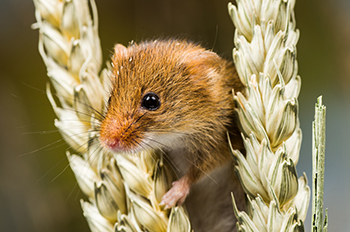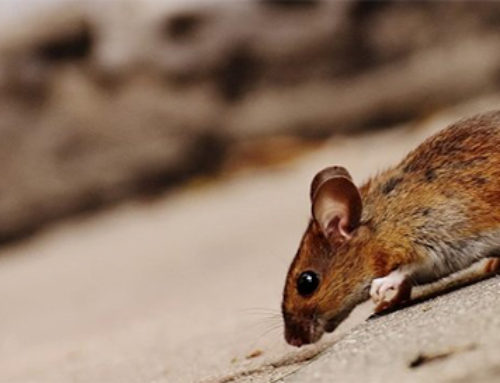Utah is the premier habitat for many critters, including mice.
According to the Natural History Museum Of Utah, there are 36 different species of rodent who call the Wasatch Front region of Utah “Home”.
In this article, we will cover the five most common mice found in Utah, their characteristics, diet and habitat.
Let’s get down to business!
5 Most Common Types of Mice in Utah
Field Mice

Field Mice Characteristics
As a cousin to the rat, Field Mice share similar characteristics. This rodent ranges anywhere from 2.4 to 6.3 inches in length, with a tail that is often just as long as its body. Its fur is very soft, and typically brown to gray in color with a white underbelly. Although, some Field Mice have more of a red-tinted coat. Eyes on these critters protrude significantly, and are solid black in color. Field Mice have large ears with very sparse fur on them. The teeth on this species will continue to grow all of its life, requiring the mouse to gnaw on hard wood, such as timber, oak and mahogany, to wear them down. In addition, the Field Mouse features quite large back feet, which provide an excellent spring for leaping.
Field Mice Diet
Generally speaking, the diet of a Field Mouse is vegetarian. Often harvesting on seeds, primarily pea and bean seeds. When they cannot find pea or bean seeds, this mouse will feast on the seeds from crops of trees, such as beech, oak, lime, ash, sycamore, and hawthorn. They also eat tubers, bulbs, and corms, particularly those which have just recently been planted. Field Mice feed right before sunrise, and again shortly after sunset. As a treat, these critters snack on small fruits and berries. When there is a shortage of food available, they will consume snails, insects, caterpillars, or fungus found underground.
Field Mice Habitat
These mice adapt well to many different habitats, and can be found in forests, grasslands and manmade structures (like your home, for example) fairly easily. That said, these rodents spend the majority of their time outdoors. Field Mice, specifically, prefer to burrow in areas with light brush.
Deer Mice

Deer Mice Characteristics
The Deer Mouse scale anywhere from 12 to 28 cm in length, when measured from nose to tip-of-tail. As far as weight is concerned, they weight around 15 to 32 grams. Deer Mice get their name from the striking similarity their fur has to that of a deer. With brown to grayish bodies and a white underbelly and legs. The most distinctive characteristic they have is their tail, which fades from dark to a very light tip.
Deer Mice Diet
Although most people believe that mice are strictly plant eaters, that simply is not true. As omnivores, Deer Mice eat a variety of different types of food. To get the nutrition they need, these mice feed on seeds, nuts, fruits, and flowers. In addition, Deer Mice eat caterpillars, beetles and carrion. When the weather is cold, these rodents bury their food and store it for consumption at a later time.
Deer Mice Habitat
As with Field Mice, the Deer Mouse adapts very well to any dry-land habitat. Most Deer Mice can be found in grasslands, forests, brushlands, agricultural fields and deserts. During cold seasons, these mice can also be found in your home, if they can manage to make their way in.
White Footed Mouse / White Footed Mice

White Footed Mice Characteristics
An adult White Footed Mouse is between 3.5 and 3.9 inches in length, not including its tail. An average weight for this species is around 1 oz. As far as coloring goes, White Footed Mice range from grayish-brown to reddish-brown, though its underbelly and legs are white.
White Footed Mice Diet
Being omnivorous, White-Footed Mice consume a variety of seeds and insects in order to survive.
White Footed Mice Habitat
White Footed Mice tend to reside in warm and dry areas, as this is their preference. They can be found in dry forests and brushlands located at middle elevation levels. Often, White-Footed Mice are found nesting inside fallen tree trunks or around old stone works, due to the fact that these spots provide good, dry homes.
Pack Rats

Pack Rats Characteristics
Considered to be medium-sized rodents, Pack Rat bodies measure an average of 8 inches long, including the tail. These rodents vary in color, some being a cinnamon to brown color, and others being gray, yellowish-gray, or buff in color. The underbelly of a Pack Rat is lighter than the back coat of fur, though not always white. These rats have a larger-than-normal ear size. One great way to distinguish these critters is by their tail, as it is covered in fur instead of being hairless and scaly, like most rats.
Pack Rats Diet
These bushy-tailed rodents consume a diet of mainly vegetation. Pack Rats eat green sprouted plants, twigs and shoots, when they’re available. Mexican Pack Rats feast on seeds, acorns, various fruits and cactus.
Pack Rats Habitat
Pack Rats tend to be a bigger pest problem for people who live in the Western part of the country. These critters are commonly found nesting inside trees, both dead and alive. However, some Pack Rats prefer to nest underground, and will dig burrows to live in. Unlike some other species, these rats stick together, and may all occupy the same den at once. This species of rat will collect plant materials, such as branches, sticks, twigs and other available debris to build their nests.
Eurasian Harvest Mouse / Eurasian Harvest Mice

Eurasian Harvest Mice Characteristics
The Eurasian Harvest Mouse ranges from 2.2 to 3 inches in length, not including the tail. Its tail is usually 2 to 3 inches long. The average weight of Harvest Mice is approximately .39 oz., which is about half the size of a house mouse. Both the eyes and ears of this mouse are relatively large in size. That said, it has quite a small nose, with short and stubby whiskers. The fur on a Harvest Mouse is soft, and grows in somewhat thicker during the winter season. In color, the body of a Eurasian Mouse is brown, sometimes with a red or yellow tint to it. They have a white or cream colored underbelly and legs. Their rather broad feet are adapted specifically for climbing, so these mice are very agile.
Eurasian Harvest Mice Diet
Harvest Mice eat a combination of seeds, insects and small berries. When conditions are rough, these rodents can live off of moss, roots and fungi. Their favorite meal would consist of grains from cereal heads, which leave the heads of these grain stock with their signature sickle-shaped remains. That being said, any noticeable damage to cereal crops is very, very rare.
Eurasian Harvest Habitat
The tiny Eurasian Harvest Mouse usually burrows in long grasslands, hedgerows, reedbeds, farmland and around woodland edges. Gardens are also great habitats for Harvest Mice. As far as shelter is concerned, Harvest Mice build an intricate structure of interwoven grass leaves, generally the size of a tennis ball. These nests provide safety, as they help camouflage the mice from predators who may be lurking. Once their nest turns brown, the mouse will leave it and build another.
What Diseases do Eurasian Harvest Mice Carry?
Salmonella
Rodents, including pets, are a potential source of Salmonella disease. Humans can contract Salmonella from rodents by eating food or water which has been contaminated with the rodents tainted feces.
Leptospirosis
Leptospirosis is a disease that consists of bacteria spread by rodents. Humans can contract this disease by eating food or drinking water that has urine from an infected rodent. Another way this disease can be picked up, is through skin membranes. For example, breathing in air that contains contaminated saliva or droppings.
Hantavirus Pulmonary Syndrome (HPS)
Hantavirus Pulmonary Syndrome, or HPS for short, is a potentially fatal disease which is spread primarily by Harvest Mice. Humans can contract this disease by breathing in dust particles that have been contaminated by the rodent, either through their saliva or droppings.
Bubonic Plague
Bubonic Plague is an infection of the lymphatic system, and can progress to lethal septicemic plague is some cases. Humans can contract Bubonic Plague if they are bit by an infected flea or rodent. The plague also has the potential to spread to the lungs, leading to a disease known as Pneumonic Plague.
Conclusion
As fascinating as it is to learn about the most common mice in Utah, it is also important to understand the danger of the diseases they carry.
You and your family are at risk for major health dangers, should a mouse (or mice) find their way into your home. It’s essential to do all you can to prevent rodents from infesting your house and causing irreversible damage. If you already suspect you may have a case of mice invasion, and D.I.Y. extermination methods have proven unsuccessful, contact a professional in Utah for mice control right away, before further damage is done to the building or those who reside inside of it.




